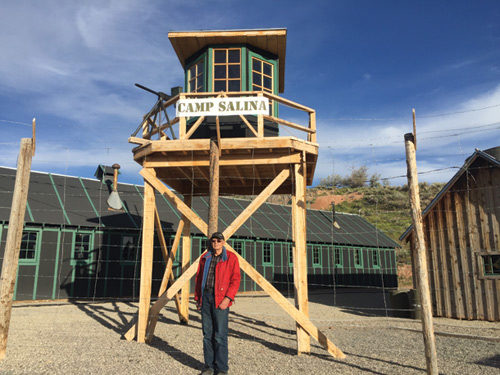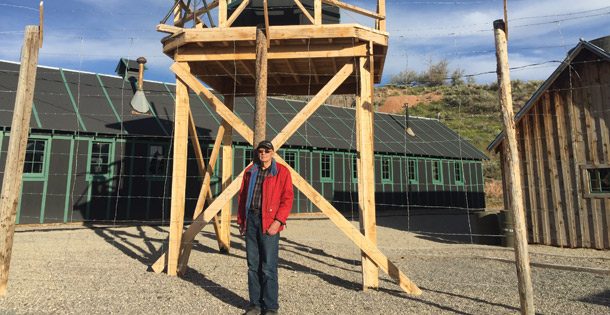
Tami Olsen had never noticed two dilapidated buildings in her small town of Salina, Utah, until the mayor asked her father to restore them. “Dad was like, ‘Okay, awesome, we have a project,’” Tami recalls. “And he just said ‘we.’” Suddenly Tami and Dee Olsen, an octogenarian retired engineer, were deep into a two-year project restoring a World War II prisoner of war camp that once housed 250 German prisoners. Now Camp Salina is open as a museum reviving this mostly forgotten piece of American history. Local families donated artifacts from the camp’s POW days, including artwork and letters from prisoners who kept in touch long after armistice. One of the museum’s prized possessions is a jewelry box a prisoner made from matchsticks and Popsicle sticks.
Letters? Gifts? Visitors are often surprised by the friendships struck up between locals and POWs. But this wasn’t unique to Salina. All over the country, in more than 550 camps holding 425,000 enemy combatants, Americans and their prisoners forged bonds.
“Prisoners brought to this country were treated quite well,” says Arnold Krammer, history professor and author of Nazi Prisoners of War in America. “They weren’t put in concentration camps. Camps were dictated by the Geneva Conventions.” It helped that many Americans had German roots. “So many Americans are of German heritage. They were so much like us racially, and our languages are quite similar.” In contrast, Japanese prisoners were generally isolated.
Since healthy young American men were away at war, prisoners were vital for harvesting crops and doing other hard physical work. Farm labor proved easier than fighting, and the food was much better. Karl Heinz Oehlmann wrote home to his family from Camp Opelika, Alabama, in 1943, practically gushing about the food: “We have cake almost daily, all kinds of fruit, Kellogg’s flakes with milk, roasts, salads, real coffee, crackers, etc. I often think how all of you would rejoice, and how urgently the children need it all. Today we have 3 large, fat pancakes and an omelet just as a side dish.”
Prisoners felt guilty about eating so well. “It’s hard to believe, but while people were starving back in Germany, we were using flour to line our soccer fields,” Josef Krumbachner, a POW at Camp Como in Mississippi, said in an oral history interview.
Why was our enemy treated with such kindness? The U.S. military was concerned about its 94,000 American prisoners in Germany, Krammer says. “We felt erroneously that as well as we take care of their prisoners, they’ll take care of ours.” He paints a surprisingly pleasant picture of the life of a German POW in an American camp, including garden clubs, dances with local girls, educational programs, lunches with farm families, even permission to drink alcohol.
This is an excerpt of an article featured in the May/June 2018 issue of The Saturday Evening Post. Subscribe to the magazine for more art, inspiring stories, fiction, humor, and features from our archives.
Teresa Bergen is a Portland-based writer who specializes in travel. She’s the author of the book Easy Portland Outdoors (Reedy Press, 2018).
Become a Saturday Evening Post member and enjoy unlimited access. Subscribe now





Comments
Strangely, there was a Camp Phillips located 8 miles SSW of Salina, KS from 1943-1945. It was shutdown shortly after the war, however none of the land was handed back over to the people who had to give it up. Nowadays, this land has been turned into the Smoky Hill Weapons ANG Range jointly ran by the Army/Air Force. It is one of the largest Testing Ranges in the country. Also included on this old POW camp site is a place known as “Crisis City”. It is the echelon in disaster preparedness training and is used by almost every Armed Forces and numerous Law Enforcement agencies. The only thing left now of the camp has been turned into a giant pig farm and deemed unsafe for public visit due to a deadly pathogen in the fecal matter. Signs detail this. There are numerous buildings and concrete pads leftover from War era. Many of the buildings were just taken down and left in a rubble of concrete. Im still trying to get access to go metal detecting. 60 miles north of Salina, KS was Camp Concordia, the largest in Kansas. Both sites were taken down and there is little to no mention of it unless you know a farmer or someone who knew there were military installations there nearly 80 years ago you would have no idea… Altogether I thought this was a great article concerning forgotten American history. Also I live in Salina, KS and I was curious when I seen Camp Salina!
I have a question: My Father was an interpreter for Italian POW’s in Utah. All the photo’s of him and other US soldiers uniforms have no markings what so ever. Just plain brown Army shirts and slack’s.
Why is it they didn’t have any patches? No name nothing!
Thanks,
Vito Cipponeri Jr.
I’m the author of GERMAN PRISONERS OF WAR AT CAMP COOKE, CALIFORNIA. The POWs at this camp and its sixteen branch camps, enjoyed the same amenities mentioned in this article. Under the terms of the Geneva Convention, the prisoners received comfortable quarters and excellent care. They filled critical wartime labor shortages inside the main Army post at Cooke and in the civilian communities, performing agricultural work for which they were paid — 80 cents a day in script. Their “money” had significant purchasing power at their canteen. Every POW camp in America had a canteen. They functioned much like a 7-Eleven store, even selling beer. On weekends and evenings, the POWs enjoyed various recreational entertainment and educational opportunities available to them in the camps. For many POWs, the American experience helped reshape their worldview and gave them a profound appreciation of American democracy.
We had a POW camp in Belvidere, Illinois when I was a young teen. They worked in the canning factory in our town and also in the fields, picking corn, peas and beans. My family lived in the country and I only saw them when we drove past the factory, but they always looked healthy, well fed and happy. I only wished our American POWs overseas had been treated as well.
A very interesting book on the subject is Stalag Wisconsin written by Betty Cowley. There were about 38 POW camps in Wisconsin. At Rockwood local women would even bring them extra food when they worked at the pea vinery. At Chilton some POWs even walked to a tavern for a beer. So many local people spoke German at that time they fit right in.
There was one at Camp Ellis, Illinois between Table Grove and Ipava. Many of Romal’s desert troops were there. They did a lot of work and seemed contented there. My father was head of the plumbing shop and a lot of them worked there and I think some would have liked to stay.
There was a German POW Camp near Sturgeon Bay, Wisconsin. My parents were both naturalized Americans. During one of the war years, we stopped to pick cherries and the POWs were picking as well. The SGT in charge of the POWs was kind enough to permit my father to speaker to the POWs, one of which turned out to be a long lost cousin. I was very young at the time but could understand decency from hatred – there was no hatred but then Wisconsin was filled with German and Polish Americans.
Camp Salina? Where? There is a Salina, KS, There was a Camp Concordia, too, located not far from Salina, KS.
I was a year old when Pearl Harbor was bombed; five when the war ended. There was a German prisoner of war camp smack dab in the middle of the United States in my hometown of Scottsbluff, NE – which is now the remodeled Scottsbluff Airport. The German prisoners lived in quansit worked in the fields picking beans, sugar beets, corn etc. On almost any given day, a drive near any of those fields and we were treated to the voices of German solders singing their German songs. They were housed in Quonset Huts and fed and treated very well.